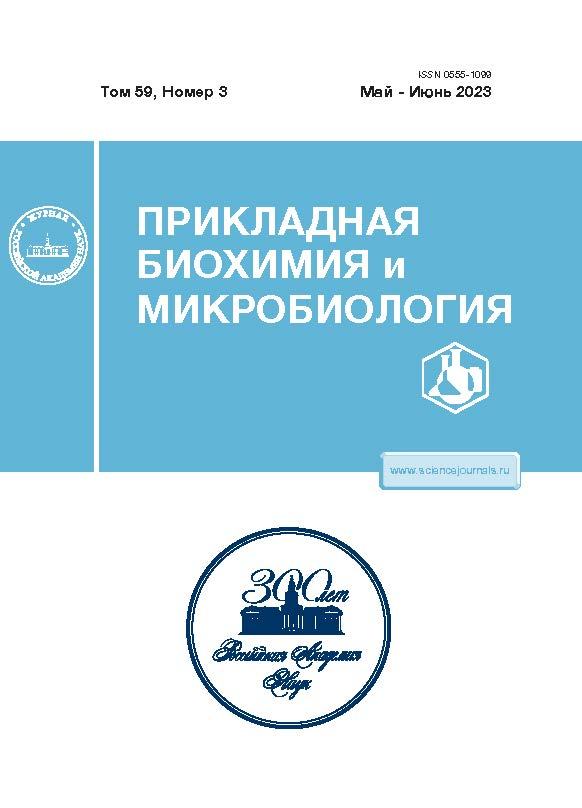Cane Pretreatment by Deep Eutetic Solvents to Increase its Reactivity During Enzymatic Hydrolysis with Cellulases
- Авторлар: Semenova M.V.1, Vasil’eva I.S.1, Yaropolov A.I.1, Sinitsyn A.P.1
-
Мекемелер:
- Federal Research Center “Fundamentals of Biotechnology” of the Russian Academy of Sciences
- Шығарылым: Том 59, № 3 (2023)
- Беттер: 253-259
- Бөлім: Articles
- URL: https://transsyst.ru/0555-1099/article/view/674619
- DOI: https://doi.org/10.31857/S0555109923030169
- EDN: https://elibrary.ru/BELOAR
- ID: 674619
Дәйексөз келтіру
Аннотация
Cane was pretreated with a number of deep eutectic solvents (DES) based on choline chloride (ChCl) as a hydrogen bond acceptor; among hydrogen bond donors, lactic and oxalic acids (LacA and OxA, respectively) were the most effective. Substrate pretreatment conditions (ratio of DES-components, temperature and exposure time) were optimized, leading to the highest yield of reducing sugars (RS) and glucose during subsequent enzymatic hydrolysis with cellulase preparation based on Penicillium verruculosum. It was been established that in the case of a mixture of ChCl with LacA (the molar ratio of components is 1 : 5) pretreatment should be carried out at 80°С for 24 h, and in the case of a mixture of ChCl with OxA (1 : 1) – at 80°С for 6 hours. The degree of conversion of the pretreated substrate after 48 hours of hydrolysis in the presence of the enzyme preparation (EP) B537 was 80 and 86% by absolutely dry substances for selected mixtures of ChCl/LacA and ChCl/OxA, respectively.
Негізгі сөздер
Авторлар туралы
M. Semenova
Federal Research Center “Fundamentals of Biotechnology” of the Russian Academy of Sciences
Хат алмасуға жауапты Автор.
Email: margs@mail.ru
Russia, 119071, Moscow
I. Vasil’eva
Federal Research Center “Fundamentals of Biotechnology” of the Russian Academy of Sciences
Email: margs@mail.ru
Russia, 119071, Moscow
A. Yaropolov
Federal Research Center “Fundamentals of Biotechnology” of the Russian Academy of Sciences
Email: margs@mail.ru
Russia, 119071, Moscow
A. Sinitsyn
Federal Research Center “Fundamentals of Biotechnology” of the Russian Academy of Sciences
Email: margs@mail.ru
Russia, 119071, Moscow
Әдебиет тізімі
- Гусаков А.В., Синицын А.П. // Химия биомассы: биотоплива и биопластики. М.: Научный мир. 2017. С. 789. ISBN 978-5-91522-451-2.
- Conde-Mejiaa C., Jimenez-Gutierreza A., El-Halwagi M. // Process Safety and Environmental Protection. 2012. V. 90. P. 189–202. https://doi.org/10.1016/j.psep.2011.08.004
- Eggeman T., Elander R.T. // Biores. Technol. 2005. V. 96. P. 2019–2025. https://doi.org/10.1016/j.biortech.2005.01.017
- Satlewal A., Agrawal R., Bhagia S., Das P., Ragauskas A.J. // Biofuels Bioprod. Biorefin. 2017. V. 12. № 1. P. 83–107. https://doi.org/10.1002/bbb.1818
- Abbott A.P., Boothby D., Capper G., Davies D.L., Rasheed R.K. // J. Am. Chem. Soc. 2004. V. 126. № 29. P. 9142–9147. https://doi.org/10.1021/ja048266j
- Gorke J.T., Srienc F., Kazlauskas R.J. // ACS Symposium Series. 2010. V. 1038. P. 169–180. https://doi.org/10.1021/bk-2010-1038.ch014
- Mbous Y.P., Hayyan M., Hayyan A., Wong W.F., Hashim M.A., Looi C.Y. // Biotechnol. Adv. 2017. V. 35. № 2. P. 105–134. https://doi.org/10.1016/j.biotechadv.2016.11.006
- Abbott A.P., Capper G., Davies D.L., Rasheed R.K., Tambyrajah V. // Chem. Commun. 2003. V. 1. P. 70–71. https://doi.org/10.1039/B210714G
- Martins M.A.R., Pinho S.P., Coutinho J.A.P. // J. Solut. Chem. 2019. V. 48. P. 962–982.https://doi.org/10.1007/s10953-018-0793-1
- Smith E.L., Abbott A.P., Ryder K.S. // Chemical Reviews. 2014. V. 114. P. 11060–11082. https://doi.org/10.1021/cr300162p
- Oliveira V.K.D., Gregory C., Francois J. // ChemCatChem. 2015. V. 7. № 8. P. 1250–1260. https://doi.org/10.1002/cctc.201500134
- Abo-Hamad A., Hayyan M., Alsaadi M.A., Hashim M.A. // Chem. Eng. J. 2015. V. 273. P. 551–567. https://doi.org/10.1016/j.cej.2015.03.091
- Bhagia S., Li H., Gao X., Kumar R., Wyman C.E. // Biotechnol. Biofuels. 2016. V. 9. № 1. P. 245. https://doi.org/10.1186/s13068-016-0660-5
- Dumitrache A., Tolbert A., Natzke J., Brown S.D., Davison B.H., Ragauskas A.J. // Green Chem. 2017. V. 19. № 9. P. 2275–2285.https://doi.org/10.1039/c7gc00346c
- Tang X., Zuo M., Li Z., Liu H., Xiong C., Zeng X. et al. // ChemSusChem. 2017. V. 10. № 13. P. 2696–2706. https://doi.org/10.1002/cssc.201700457
- Zhang C.-W., Xia S.-Q., Ma P.-S. // Biores. Technol. 2016. V. 219. P. 1–5. https://doi.org/10.1016/j.biortech.2016.07.026
- Количественный химический анализ растительного сырья. / Ред. В.И. Шарков, И.И. Куйбина, Ю.П. Соловьева, Т.А. Павлова. М.: Лесная промышленность, 1976. С. 63–64.
- Morozova V.V., Gusakov A.V., Andrianov R.M., Pravilnikov A.G., Osipov D.O., Sinitsyn A.P. // Biotechnol. J. 2010. V. 5. № 8. P. 871–880. https://doi.org/10.1002/biot.201000050
- Dotsenko G.S., Gusakov A.V., Rozhkova A.M., Korotkova O.G., Sinitsyn A.P. // Process Biochem. 2015. V. 50. P. 1258–1263. https://doi.org/10.1016/j.procbio.2015.05.008
- Синицын А.П., Черноглазов В.М., Гусаков А.В. Итоги науки и техники. М.: ВИНИТИ, Биотехнология. 1990. № 25. С. 148.
- Sinitsyn A.P., Osipov D.O., Rozhkova A.M., Bushina E.V., Dotsenko G.S., Sinitsyna O.A. et al. // Appl. Biochem. Microbiol. 2014. V. 50. № 8. P. 761.
- Kumar A.K., Parikh B.S., Pravakar M. // Environ. Sci. Pollut. Res. 2016. V. 23. № 10. P. 9265–9275. https://doi.org/10.1007/s11356-015-4780-4
- Jablonsky M., Škulcova A., Kamenska L., Vrška M., Šima J. // Biores. 2015. V. 10. № 4. P. 8039–8047. https://doi.org/10.15376/biores.10.4.8039-8047
- Wahlstrom R., Hiltunen J., Pitaluga De Souza Nascente Sirkka M., Vuoti S., Kruus K. // RSC Adv. 2016. V. 6. № 72. P. 68100–68110. https://doi.org/10.1039/C6RA11719H
- Lynam J.G., Kumar N., Wong M.J. // Biores. Technol. 2017. V. 238. P. 684–689. https://doi.org/10.1016/j.biortech.2017.04.079
- Francisco M., van den Bruinhorst A., Kroon M.C. // Green Chem. 2012. V. 14. № 8. P. 2153–2157. https://doi.org/10.1039/C2GC35660K
- Tian D., Chandra R.P., Lee J.-S., Lu C., Saddler J.N. // Biotechnol. Biofuels. 2017. V. 10. № 1. P. 157. https://doi.org/10.1186/s13068-017-0846-5
- Procentese A., Johnson E., Orr V., Garruto Campanile A., Wood J.A., Marzocchella A., et al. // Biores. Technol. 2015. V. 192. P. 31–36. https://doi.org/10.1016/j.biortech.2015.05.053
Қосымша файлдар










